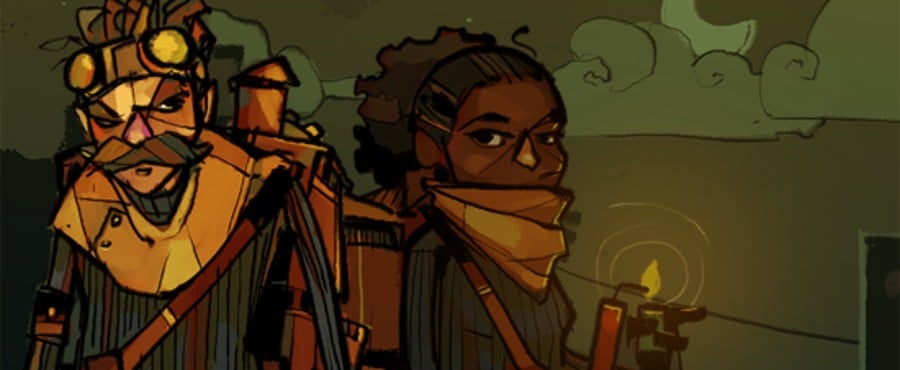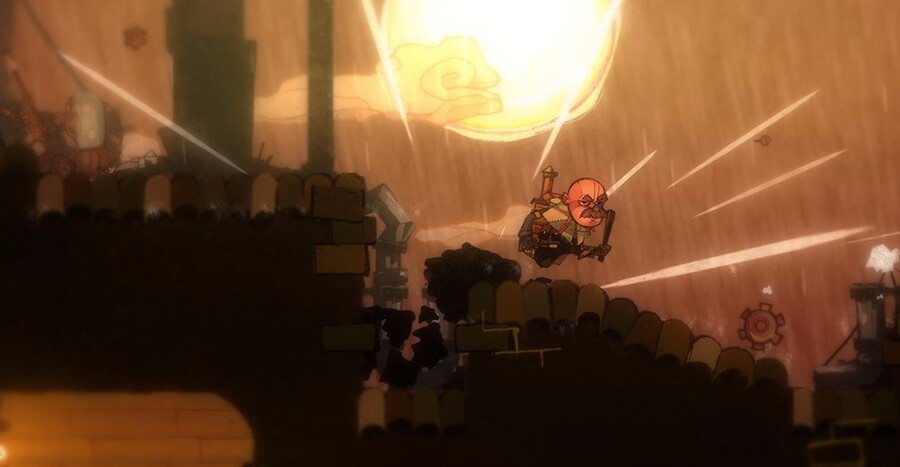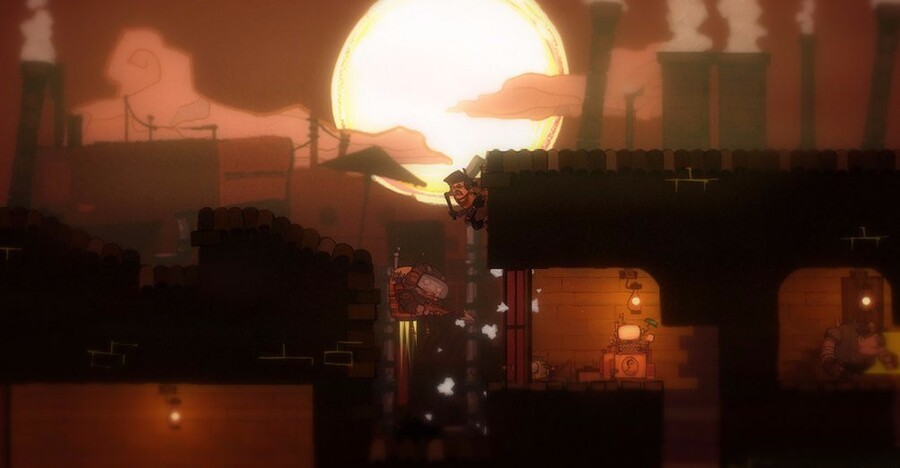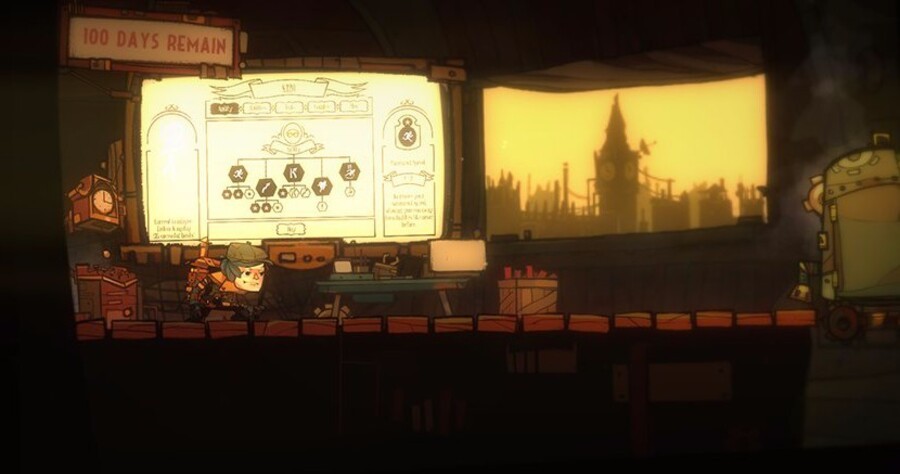The Swindle is planned for the Wii U eShop this Summer, and it brings an interesting blend of action, platforming, strategy and humour. With a steampunk aesthetic, procedurally generated levels, its combination of styles and design approaches left us impressed in our first impressions.
When going hands on with the game we had the opportunity for a detailed chat with its creator, Dan Marshall, and recently published a segment of the interview focused on his development history and route to consoles with his studio, Size Five Games. In this second part we discussed The Swindle's original cancellation on PC, its revival and and details around the game's humour, design and mechanics.

So, how did The Swindle come back, because it was off for ages.
I cancelled it.
 Watch on YouTube
Watch on YouTubeSubscribe to Nintendo Life on YouTube840k
Then announced it was back in October.
Yeah, it was. It was basically one of these things that the game on paper was great but the systems just weren't gelling together in a way that was making it fun. So there was a lot of stuff going on with how the stealth works, how the guards worked and how the levels worked that theoretically was great but in practice just wasn't working. So I cancelled it and I said, "It's cancelled. I'm not making this anymore. I'll make something else instead." Then I played Spelunky and I thought to myself, this is what The Swindle needed. The Swindle needed procedurally generated levels like this and it needed dumb guards like this, 'cause the guards are just predictable, right, they're not dumb, they're predictable. So I put together a prototype in a week. You see I don't know anything about procedurally generating a building. I didn't even know how you would do it, but I thought, well, I'll see if I can get a building and get it running nicely around that.
In a week I had these little rectangles shuffling around a procedurally generated building, and I was losing hours at a time to it. I was just sort of fixing a bug or something, or adding a feature, booting it up, and then an hour would go by 'cause I'd just be playing it. I'd be sitting there with rectangles clobbering rectangles over the head with other rectangles and it just, you know, looked disastrous - but it was fun to play. It was really engaging to play. It had that feeling of another go, another go, another go, another go. So, yeah, it was just one of those things that I gave it a week to see if it was worth bringing back, and was so into it that I didn't have a choice really. I hired in Michael Firman to do the art because I thought I want to get this done. If I'm going to do it and I'm going to start it up again, I want to get this done really quickly. So I was like, you know, the levels have been procedurally generated now, it can't take me more than six months to make this game, as quite a lot of the code was like Gun Monkeys' code [a previous release], like the character control was lifted.
Here we are thirteen months later and it's expanded, and it's just one of those things that kept on getting bigger and bigger and bigger; you just think "I want to do this justice". You know at the moment this is a good game, what would make this a great game is 'if', and there was no reason not to punch for that great game status and keep going for it.

Although it's procedurally generated, there's still progression there, and I guess that's the difference. There are a lot of games that are just changes of level every time and you just play it again and again with no real purpose, but you've got a purpose here with your underlying structure.
Yeah, that was one of the things I didn't like about Spelunky is that when you die you lose everything, right, everything's gone. There's no sense of progression. Whereas here, in between heists you can go back to your airship, upgrade your tools and you can buy your way into new levels, bigger security zones, and all that sort of stuff. So it's more like a RPG in terms of there's a skill set that you are building up. It has definitely got that sense of progression. It's so tempting to just keep putting new things in. I'm still putting robots in. I'm still putting new baddies in. Because you play through it and you think, you know, it'd be good if there was a baddie type that would block off that area, so I had to think around and go around another way. You know, what new stuff can I throw at the player that's interesting to play against? So I'm still putting stuff in; it's still going.
Well, one thing I noticed playing it - obviously you've done a lot of different kinds of projects, you've done a lot of comedy as well - is that there's plenty of humour; does that drive the design of it? Because there are little things, there are always explosions, everything explodes, and quite a few times it was catching me out with unexpected events.
I think the humour from it very much comes from … like I've pulled all the plot out of it. It had plot at one point and it got in the way and was ruining the game. It's not that game; it's an arcade game. It works better with a bare bones set-up, rather than characters, plot, dialogue, and all that sort of stuff. Which is quite hard for me, because I just desperately want to write some voice-over, and write some scripts, some dialogue, and put stuff into it, but it's not that game, it's not going to work. So the humour, I know it's silly, but it's the most serious game I've made, I suppose. Well, the most serious game I've made in a long time anyway, but there is a flippancy to it, the robots, the guards etc are all hilariously stupid. You know they're all sort of shonky steampunk idiotic guys.

There can be an explosion over their head and they won't notice a thing.
Yeah. The humour comes from hacking a robot so that he runs at another guard and wallops him and that guard goes smashing through a window; these things that I can't write but will happen naturally anyway that are funny. I put in a thing the other day, I put in a couple of things that have made me laugh, 'cause there are enemies later on that spawn other enemies if they hear you, so you can get heard at some point. There are these listener bots that launch these tiny little mini drones at you if they hear you, and it's funny that they sort of swarm; you get six of them swarming and chasing you through. That's where the humour comes from, rather than from me saying, "Here's a joke about stupid robots."
Is it easier for you as a developer once you have the structure to generate the levels and you've established all the rules and the enemies, does it give you a kick to see how it behaves and the weird scenarios it'll throw up?
That's one of the great things about a heist game like this - you get confident, you get cocky and you've got a plan, then suddenly something happens that ruins that plan.
Yeah. It's a really nice way of making games. It's really nice being able to just tinker with things, endlessly tinker with things. Like I'll play it for an hour and then go with a notepad and I'll just say, that's not as clean as it could be, that's not quite as good as it could be. You change a couple of figures and it's all just that little bit finer, that little bit more perfect. And there's little things like giving different feels to the buildings in different districts, so the casino buildings would be tall and thin, for example, or might generate buildings that have bay windows, and that's done from a design challenge point of view. So all the walls in the first few levels are just straight and you can climb up them, and eventually you'll start getting bay windows, or buildings that sort of jut out a little bit, so you're going to need bombs or double jumps and stuff to get around them. So it's quite nice playing it and then going "What could I throw in there to make it more interesting? What other stuff can I put in to ruin the player's day a little bit?" You know, because that's one of the great things about a heist game like this - you get confident, you get cocky and you've got a plan, then suddenly something happens that ruins that plan.
Well, like the wrong mine blowing up.
Like a mine blowing up or, you know, there's these things … I'm not 100 per cent sure they're going to make it in, but I do love them … which are horrible, 'cause I was thinking about putting a bomb in a level, but you don't really care about a bomb in a level as it's not your house, right? So I was thinking about having other challenges to do, like you could go around defusing bombs and all that sort of stuff. It was like, well, why wouldn't you just leave? That doesn't make any sense. I put this thing in, it's mean but I love it, in that you're in the middle of a level, quite big levels as well, they're quite deep, and if you're deep in there, you've got a plan and you're in the rafters waiting for the perfect opportunity to take out a couple of guards so that you can hack a computer, and all of a sudden there's a warning comes up that there's a leech on the roof, and what the leech does is it's like a satellite dish thing that drops from the sky and it starts draining money from your bank account, right, so all the money you've made from all the heists is slowly tricking down.
So all your plans are basically ruined, and you have to just leg it out of the building and get onto the roof as quickly as you can to take it out. And it's just these little things that when you're playing you can sort of think "What can I stick into this that will …" So one of the things about procedural games is that random stuff happens; "What random happenings can I do to make each level feel more unpredictable, to feel like things could go wrong? What can go wrong?" So, yeah, there's a lot of that.

But you still progress. You mentioned different kinds of buildings and areas.
Yeah. So the way it works is that you start off with access to the slums, which is the poor district, and at the end of each heist you go back to your airship, or you can go back to your airship and upgrade your kit. One of the upgrades on the airship is better security clearance.
So if you buy security clearance for the warehouse district, you can go to the warehouse district. The warehouse has got slightly more money in it than the slums have obviously, then the mansions have got slightly more money than the warehouse, and the casinos have got a lot more money than mansions. So it's about, you know, "Have I got enough upgrades to take on the next level and do I want to spend this much money on upgrading the next level yet?" So you choose how you progress.
But there is this constant ticking clock in The Swindle which is the plot, the bare bones plot that there is, revolves around the idea that Scotland Yard have announced that they're going to plug-in this artificial intelligence. It's a steampunk artificial intelligence, it's like this big brass skull, and it's going to have 100 per cent surveillance over the whole of London. As a thief, that's going to ruin your job because you won't be able to be a thief any more.
So you go back to your airship and it'll say 99 days remaining, 98 days remaining, 97 days remaining. For the first few times when you're just f****** up, it's like "hey, whatever", and then suddenly it gets down to 60 and you start to think."
The end game is to steal this thing. So the start of the game it says, you know, they're going to turn on this AI in 100 days. So you've got 100 days before they turn it on, and every time you do a heist, whether you die or whether you go back to your airship at the end, every heist is one day off the counter.
So you go back to your airship and it'll say 99 days remaining, 98 days remaining, 97 days remaining. For the first few times when you're just f****** up, it's like "hey, whatever", and then suddenly it gets down to 60 and you start to think, "I've only got 60 days left to do all these heists, to get all this money and get all this stuff." Then suddenly it gets down to 30 and 20 and 10. One of the upgrades on your ship is you can buy a bit of kit for your airship which lets you hack Scotland Yard, which slows progress on the AI by two days. So you can buy yourself 48 extra hours, which is two extra heists, but by the end you're down to 10, 15 days, or whatever, and you've got 20 grand. "Do I want to spend 10 grand on another two days, or do I want to spend that 10 grand on more kit so that I can go to the next security level". So there's all these horrible decisions in play.
And conceivably you can have a whole play through where you don't quite make it and you just start again.
You can. You can fail and they turn it on and then that's it, you get arrested and that's your job and you're gone.
I spent all this time, I spent like three days, doing the end cut scene and it's not even a very long cut scene. I spent days doing this end cut scene for if the AI gets turned on and you get arrested. I'm like "No one's ever going to watch this" because once you get down to like 5 days, you're going to start again.People are just going to go to the title screen and select 'Start new game', right? So, yeah, I was thinking, "No one's going to see this. No one's going to see this." Purists might see it, but no one else is going to see it. It's like XCOM, when everyone leaves XCOM; it never really gets that far because once you've lost 90% of things, there's no point in starting loading that game up; you might as well start a new one.
With thanks to Dan Marshall for his time and to Curve Digital for arranging the interview.

Comments 4
Sounds good.
I love XCOM and its asphyxiating atmosphere and I'm still playing it. This game seems to have many thing in common with the Fireaxis game.
Among the different Indie games that Nintendo lately showed on YouTube, this is the one I'm most interested in. Please be good!
For a second there, while reading the title, I thought this was cancelled again! Really glad to see that's not the case and a lovely interview to boot!
Also guess I'm a purist, because I'll definitely play through end even if it's clear I won't be able to get everything done before the days run out.
Looks really cool! I like the idea, sounds fun
Show Comments
Leave A Comment
Hold on there, you need to login to post a comment...